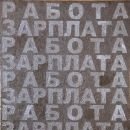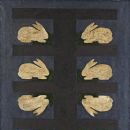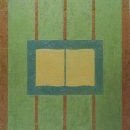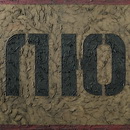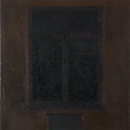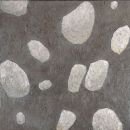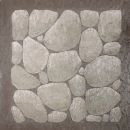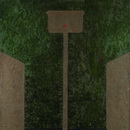The dualism inherent in all the creativity of Sergei Evgenevich Volkov arises at the intersection of two trends – metaphysics and conceptualism. He started out as a pure painter and it was as a painter that he was celebrated. For example, he would paint flowers but the subject of the painting was not particularly important. An enlarged splotch of plaster was the main theme of the artist’s paintings. He also invented the so-called ‘dust technique’. His intention was to show the audience a nonentity, to catch and fix a moment before the object disappears. The series entitled ‘Dusty models’ was completed by the artist in 1994 for two exhibitions in Moscow held at the same time, one at the XL Gallery and the other at the Aidan Gallery. The models at the Aidan Gallery were in their final form and represented miniature copies of ‘largel’ objects such as a settee, a wooden tower, a plinth for a sculpture etc. At the XL Gallery, the illusiveness of the ‘dusty’ technique was sufficiently expressed in the forms of objects which were more abstract and conceptually unrealistic. At first glance, the ‘Dusty models’ series without doubt belongs to the aesthetic of Moscow conceptualism. However, the inherent value of the ‘dusty object’, admiring it and careful storage (the model is placed for storage in a vacuum flask made from green laboratory glass) and qualities inherent in the thoughtful concentration of a metaphysical artist, although understanding the value of ‘emptiness’ with its logic of development in time and space is closer to the conceptualists.
THE TSUKANOV ART COLLECTION
 |



 |
Volkov Sergei | «Artists of my generation are trying to fashion art into a form which can adequately represents the localized condition of the collective consciousness… My paintings refer one the one hand to the notorious Post-Cezanne painting in the Official Moscow School, and on the other hand to the badly painted walls of halls, corridors ad rooms which provide the backdrop to our daily Soviet lives”. |
Born in 1956 | ||
“For all this period (1987-1991)in the Volkov’s art the primitive forms and restrained colouristic gamma (though refined in its own way) of grey-brown-green dirty paints, slapped on in a thick layer in stains and peelings that are more appropriate for the painting of prison walls, were harmonious with Soviet angst and adequate to the epoch of mass deficit,” – Faina Balakhovskaya.
The artist's work can be found in the following museums and collections:
| Dusty Models The State Tretyakov Gallery |

